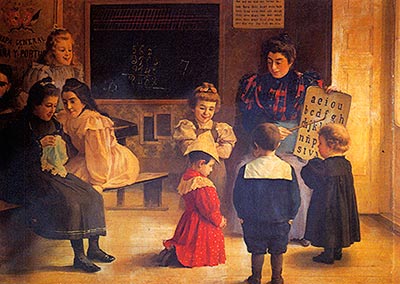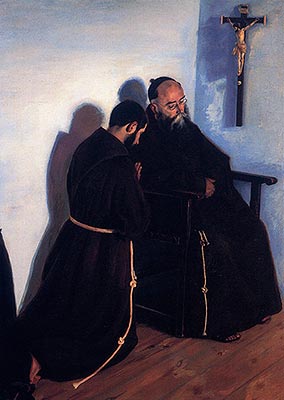BRINGING HERITAGE CLOSER. TUDELA
5 September 2008
Tudela and Navarrese painting from the period between the centuries
D. Ignacio J. Urricelqui Pacho. Chair of Navarrese Heritage and Art
During the transition from the 19th to the 20th century, Tudela was no more than a third-rate pictorial centre, bearing in mind that Pamplona, as the capital of the province, was a second-rate venue in relation to the main artistic centres of the time such as Madrid, Barcelona, Bilbao, Valencia, etc. The real existence of an artistic environment in Tudela in those decades depended on the existence of at least four fundamental factors: the promotion of the artistic training through local centres and the granting of pensions and artistic aid; the establishment of promotional mechanisms - exhibitions, competitions, art contests, etc.; the presence of art critics; and the work of institutional and private clients. With regard to the artistic training , the Castel-Ruiz Drawing Academy, which had been active since the 19th century, enabled young artists from Tudela to learn the rudiments of drawing, although the lack of a solid policy of pensions and aid for training from local institutions made the process difficult. Nor were there many exhibitions, except for a few held at the Castel-Ruiz premises, which in turn prevented the consolidation of a local art critique and, with it, an effective clientele.
In any case, during the years between the centuries, there were several quality artists from Tudela who, moreover, were fully connected with the artistic environment of their time both in Navarre and beyond. Among them, Nicolás Esparza and Miguel Pérez Torres stand out with their own names, the former born in 1873 and the latter in 1894, and although from different generations, they contributed to the artistic level in the capital of the Ribera del Duero, at least in the field of painting, development .
Nicolás Esparza trained at the Castel-Ruiz Academy, although thanks to a financial aid grant from the Diputación de Navarra he was able to study at the Special School of Painting, Sculpture and Engraving in Madrid during the 1890s, where he studied at training at subject , an academic school based on drawing, composition and modelling. He frequented the halls of the Prado, copying masters of the past such as Velázquez and Goya, or more contemporary artists such as José Benlliure and José Casado del Alisal, and took part in the National Exhibitions of Fine Arts with paintings such as "At School", which won him an honorary accredited specialization in 1899, sharing award among others with a young Pablo Ruiz Picasso, decorated for the canvas graduate "Science and Charity". On his return to Tudela, Esparza worked for the Town Hall and for the local clientele, although the scarce artistic environment there led him to sit the tests for civil service examination in 1910 to fill the place post of drawing teacher at the School of Arts and Crafts in Sestao. Having obtained the post, he went there, teaching and working for the Biscayan clientele until his death in 1928.

Nicolás Esparza, "At School", 1899
Miguel Pérez Torres, for his part, began his career as a self-taught painter, training , although he was in contact with Javier Ciga, one of the leading figures in Navarrese painting at the time. Thanks to a grant from the Diputación de Navarra, he went to train at the School of Arts and Crafts and Fine Arts in Barcelona, where he was student under José Mongrell. He began to take part in the National Fine Arts Exhibitions with canvases such as "La confesión del capuchino" ("The Capuchin's Confession") and "En la Ribera de Navarra" ("On the Navarrese Ribera"), paintings dedicated to the customs and types of the Ribera. On his return, he worked in Tudela, dealing with themes of types and customs of the Ribera. In his works, apart from the costumbrista sense, a symbolic intentionality sometimes seems to be discernible. In the 1930s, he also taught at the Special School in Madrid and later devoted himself to teaching , first at high school in Tudela and later in Pamplona, where he died in 1951.

Miguel Pérez Torres, "The Capuchin's Confession", c.a. 1922
Both artists were "men of their time", in the sense that they lived the same experiences as the artists of their respective generations, always within official spheres where the San Fernando School of Fine Arts and the National Exhibitions of Fine Arts were fundamental references in their training and promotion. His painting followed the path of traditional art, correct and of B technical quality, attentive to drawing, composition and modelling, and to the application of a colouring attentive to the natural, lacking in plastic experimentation, far removed from the modernising trends of the late 19th century and the avant-garde of the early 20th century.
Apart from Esparza and Pérez Torres, Tudela also witnessed the birth or work of other notable painters such as the Murchantino Jesús Basiano, or more discreet ones such as José Serrano Amatriain, Florentino Andueza and Rosa Iribarren, not forgetting that in the classrooms of the School of Fine Arts in Madrid several Tudela artists were trained in the period between centuries whose names do not tell us much today but who, in their time, confirmed the undisputed preponderance of this artistic centre as well as the artistic reality of a provincial town. We are talking about Francisco Jiménez Magadalena, enrolled between 1877 and 1879; Gregorio Bernal Cabañas, between 1886 and 1891; Félix Álava Escalada, between 1899 and 1901; Luis Zapata Milán, between 1899 and 1900; and Carlos Casuso Obeso, between 1900 and 1906.
PROGRAM
TUESDAY, 2 SEPTEMBER
Place: Tudela. Dean's Palace
16.30 h: Opening and presentation of the course
16.45 h. The recovery of the ornamentation of Tudela Cathedral
Ms. Mercedes Jover Hernando. Chair of Navarrese Heritage and Art
17.45 h. Coffee break
18.15 h. Santa María de Tudela and the medieval architecture of the Ebro Valley
Mr. Javier Martinez de Aguirre Aldaz. Complutense University of Madrid
19.15 h. Artistic relations between Aragon and Navarre in the 15th century: the case of Tudela Cathedral
Ms. Carmen Lacarra Ducay. University of Zaragoza
20.15 h. visit guided tour of the cloister of Tudela Cathedral
WEDNESDAY, 3 SEPTEMBER
Place: Tudela. Dean's Palace
16.30 h. Architecture and the city in the 16th century
Ms. María Josefa Tarifa Castilla. Chair of Navarrese Heritage and Art
17.30 h. Coffee break
18.00 h. Illustrious women of the Renaissance in the Magallón palace
Ms. Mª Concepción García Gainza. Chair of Navarrese Heritage and Art
19.00 h. visit to the Magallón palace
THURSDAY, 4 SEPTEMBER
Place: Tudela. Dean's Palace
16.30 h. Art and devotions in Tudela between the 16th and 18th centuries
D. Ricardo Fernández Gracia. Chair of Navarrese Heritage and Art
17.30 h. Coffee break
18.00 h. visit guided tour of the convents of the Company of Mary, Capuchin and Dominican nuns in Tudela
FRIDAY, 5 SEPTEMBER
Place: Tudela. Dean's Palace
16.30 h. Art, report and collective identity: The commemorative monument in the city of Tudela
Mr. José Javier Azanza López. Chair of Navarrese Heritage and Art
17.30 h. Coffee break
18.00 h. Tudela and Navarrese painting from the period between the centuries
D. Ignacio J. Urricelqui. Chair of Navarrese Heritage and Art
19.00 h. The Bardenas and La Mejana. Landscape and still life in Tudela painting
D. Manuel Motilva Albericio. Director of the Muñoz Sola Museum in Tudela.
20.00 h. Closing ceremony
